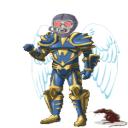Yahoo Answers is shutting down on May 4th, 2021 (Eastern Time) and beginning April 20th, 2021 (Eastern Time) the Yahoo Answers website will be in read-only mode. There will be no changes to other Yahoo properties or services, or your Yahoo account. You can find more information about the Yahoo Answers shutdown and how to download your data on this help page.
Trending News
What is the purpose of a buffer car?
A buffer car is a different type of car at the beginning and/or end of a unit train consisting of nothing but tank cars, usually a covered hopper or a boxcar. But what purpose does it serve?
6 Answers
- AndyLv 77 years agoFavorite Answer
For collision protection.Also to keep a shiftable load(like a ribbon rail train) from hitting the engine. And to provide separation between a hazardous load and the engine.
Source(s): UPRR engineer - ?Lv 67 years ago
This "side of the pond" they are called "barrier wagons", usually one or two empty wagons (cars) of any type marshalled at either end of potentially dangerous loads like fuel oils, chemical, inflammable/poisonous gases and substances, nuclear fuel flasks and so on. They are there to protect the load from damage (and consequent hazard) in the event of minor or moderate collision.
The attached pic shows a nuclear fuel train in the UK in the 1990s with empty hopper wagons on either side of the flask carrier, and brake van (caboose) at the rear
 Source(s): Retired UK Train Driver
Source(s): Retired UK Train Driver - KennyLv 77 years ago
The only thing i can think of is to help with the sloshing of the liquid in the tanks from back to front .
The only unit trains I worked were coal trains .
- StephenWeinsteinLv 77 years ago
One reason is to keep the tank cars and the locomotive away from each other, so that if the locomotive catches fire, the fire is somewhat less likely to spread to the tank cars and make them blow up.
- How do you think about the answers? You can sign in to vote the answer.
- Hairy JimLv 67 years ago
They can act as a gap in the case of diesel locomotives/fuel tanks... also, in the case of moving odd rolling stock around, may have different couplings at each end, to enable "foreign" locomotives to haul it.






